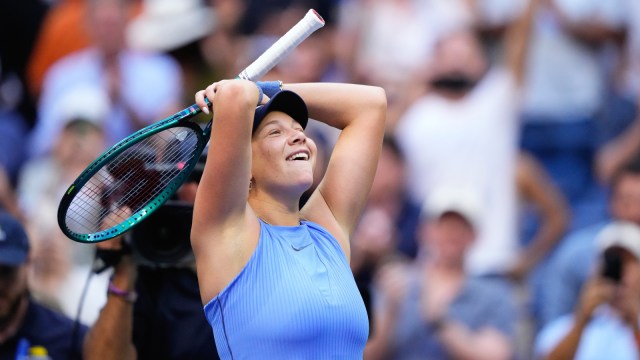Watching highlights of Wimbledon final drubbing, and then removing it from brain: How Amanda Anisimova turned the tables on Iga Swiatek at US Open
Anisimova has struggled with mental health issues in the past, having had to take a break from the sport, but showed admirable resolve to come out on the right side of a high-quality contest. But the turnaround began by revisiting some unpleasant match footage.
 Anisimova proved that she would not be defined by the memories of her painful Wimbledon rout, where she lost the final 6-0, 6-0 (Double Bagel) to Swiatek, as she beat the second-seed of the event 6-4. 6-3. (Photo: AP)
Anisimova proved that she would not be defined by the memories of her painful Wimbledon rout, where she lost the final 6-0, 6-0 (Double Bagel) to Swiatek, as she beat the second-seed of the event 6-4. 6-3. (Photo: AP)Facing up to failure and taking a good hard look at oneself is often the first step to success. That’s exactly what Amanda Anisimova did to bounce back from a double bagel in a Wimbledon final to achieve what she called “the most meaningful victory of my life.”
The American was thrashed 6-0, 6-0 by Iga Swiatek in the summit clash at SW19 a little over a month and a half ago, but turned the tables on the Polish second seed in the US Open quarterfinals, prevailing 6-4, 6-3 at the Arthur Ashe Stadium.
Anisimova has struggled with mental health issues in the past, having had to take a break from the sport, but showed admirable resolve to come out on the right side of a high-quality contest. But the turnaround began by revisiting some unpleasant match footage.
“I watched them [highlights] back, as painful as it was, just to see what I can avoid or what went wrong,” Anisimova said after her passage to the semifinals, where she will face former champion Naomi Osaka of Japan.
“Then afterwards I had to watch some good highlights to remove that from my brain!”
The 24-year-old said the drubbing at Wimbledon had not left any long-term scars.
“I feel like I was able to bounce back from it really quickly. Maybe a few years ago I wouldn’t have done as well as I have this time. I would have maybe blamed myself more or held on to the guilt for longer,” she felt.
“On the court I was crying, and maybe [for] 30 minutes afterwards, but then I got on the phone with someone and I kind of laughed it off. At the end of the day, it was just tennis.”
Positive reinforcements
Anisimova’s positive reinforcements helped in the turnaround.
“I made a point to myself, and also maybe to other people, that if you really put a positive mindset out there, then you can have a positive outcome.”
She diverted her thoughts to the spectators who had spent a lot of money to watch the Wimbledon women’s singles final, and didn’t get to see a worthwhile contest.
“Truly, the most that I felt bad was for the people that had come to watch that day,” she said. “I know how much people pay for those tickets and are excited to see Wimbledon. I kind of had that guilt on my back, as opposed to winning my first Grand Slam final.”
Finding happiness outside the tennis court has played a part in Anisimova dealing better with challenges on it.
“I’m in a really good place in my life. I’m happy every single day, which I wasn’t a couple of years ago,” she felt.
































